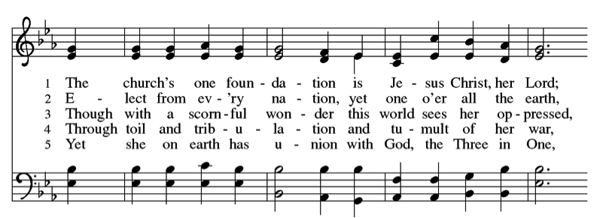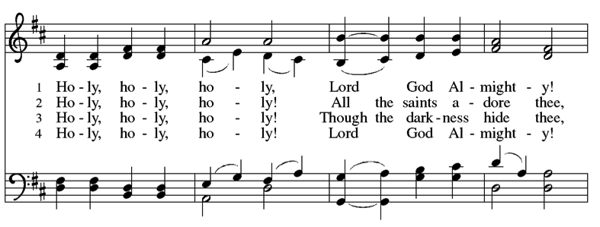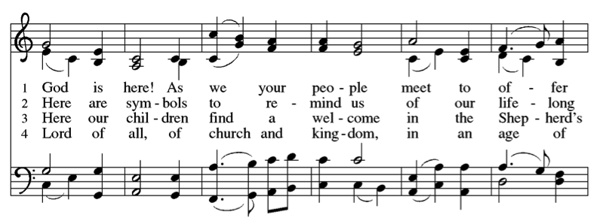“The organist plays so fast I can hardly catch my breath.”
“Every hymn is like a dirge; why can’t the organist play faster?”
These are phrases we’ve probably all heard at least once. Exasperated parishioners will use whatever language they know to describe a common issue in worship. What is the right tempo for a hymn? Is there a “right” tempo for a hymn? And how do we enliven our assembly song so that our hymns do not feel like “a dirge?”
I would suggest that many tempo issues have nothing to do with tempo at all, instead that the TACTUS is not clear. While tempo is important, and we will discuss that later, the most important concept to keep in mind when leading assembly song is that of tactus.
What is tactus? Tactus is the underlying, inner pulse. It’s the life force of a piece of music. It’s what provides forward momentum and keeps our song from stalling. Tactus is the lifeblood coursing through the veins of assembly song. If our tactus is unclear, we may feel like we are suffering coronary arrest. Tactus moves in a linear fasion. Tactus is the horizontal flow of the melody.
How do we determine where the tactus of a piece of music lies? Often times the tactus is the larger beat, the larger pulse of a hymn. Take the following example:
We see several measures made up of mostly quarter notes. If this hymn had a time signature, it would most likely be 4/4. If we felt the pulse as the quarter note, the result might be a march-like, militant treatment.
If, however, we view the tactus or pulse as the HALF note, our treatment of the hymn changes greatly. What if we look at the time signature as 2/2 rather than 4/4? The hymn has forward momentum. We think horizontally with the melody, rather than vertically with the harmony.
Here’s another example:
Again, we have a hymn that appears to be in 4/4 meter. We observe many repeated quarter notes. We are probably all very familiar with this hymn, and have heard it sung in many different ways, in many different settings.
What happens if we think of this hymn in 2/2 rather than 4/4? The pulse is the half note. The strong pulse is on beat 1, and the secondary beat is the second half note. The phrase moves on in a linear (horizontal) way.
How do we demonstrate our new understanding of tactus when we lead the assembly in song? First, I would sing each hymn and keep time, either by counting to myself, or by tapping my foot, in the larger beat. I would tap my foot on each half note. This concept might be foreign at first, but will help place the pulse in the proper place.
Next, if I were an organist, I would tie together the repeated quarter notes in the bass line. In our “Holy, Holy, Holy” example above, the Ds in and the Bs in the first measure would be tied together. In the third measure, the two low Gs are already tied together, and I would also tie together the other Gs. Thus, the bass line emphasizes the half note, and provides the basis for a strong tactus. The concept works the same if you are leading from piano.
The first example is a little more tricky. In the bass line of the first measure of “The Church’s One Foundation,” we have four Eb quarter notes in a row. I would tie together the first two, and also tie together the last two, turning four quarter notes into two half notes. The bass line emphasizes the half note, and makes the tactus clear.
Here’s another example:
This looks like a straight forward hymn in 3 /4. But before we turn it into a waltz, let’s think a little more carefully. Sing through the tune. Where is the strong pulse? Try singing it again, thinking one beat per measure. Perhaps the tactus of this hymn is a dotted half note.
Understanding the concept of tactus can correct many issues related to song leading. When I interviewed for my present position, I was warned in not so subtle ways that this congregation expects snappy, fast hymns. My first Sunday, I took the opening hymn quite fast, and unfortunately left my poor congregation in the dust… By the hymn of the day, we settled on a more accessible tempo, and the rest of the worship service went quite smoothly. I learned my lesson, that when they asked for lively hymns, they weren’t necessarily asking for a fast tempo.
Four years later, I won’t say that I’ve heard many complaints about the hymns not being fast enough. Because I have a clear understanding of pulse, and because the hymns always feel like they have forward momentum, our singing is filled with energy.
What factors help us determine a “right” tempo for a hymn? (Notice I say A right tempo and not THE right tempo.)
I’ll never forget the organ jury I played during college when we were asked to play a hymn as if we were leading an enthusiastic congregation. I don’t remember the hymn, but I do remember that one member of the organ faculty told me the tempo was too slow and the other told me it was too fast. How do we decide?
The acoustic in the room is one important factor. A live acoustic means that our playing needs to be crisp and our articulation requires greater clarity.
If you have an enthusiastic assembly, and they are singing very well, you may need to negotiate with them on tempo. I have played for Synod events or clergy gatherings where the people wanted to sing with full voice at a tempo slightly slower than I would have picked. I felt my role was to support them, lead them, encourage them, but not push them. Sometimes we need to get out of the way and let the people sing.
Each tempo we select should be thought through prior to the start of worship. But we need to display a sense of flexibility as well. I can’t tell you how many times I have had something in mind for the treatment of the hymn after the sermon. And then I hear the sermon, and my treatment changes to reflect the mood of the message. This is one reason we will never be replaced by machines: because we see and hear and observe the other elements of the worship service and draw them together.
If the singing in your setting is a tad on the anemic side, try reinforcing the idea of tactus. Demonstrate on a steady pulse. Think like a singer. Provide ample musical direction, and the singing will improve. Your assembly needs to learn to trust you, and you need to demonstrate to them that you are worthy of that trust.
Note: This topic and much more are addressed in a workshop, “Leading the Assembly’s Song” that is available for ELCA synods to sponsor. For more information, contact Scott Weidler, ELCA Program Director for Worship and Music, at scott.weidler@elca.org.







